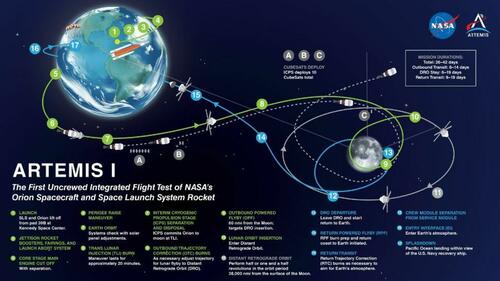NASA Detects ‘Fuel Leak’ For Artemis 1 Moon Rocket Just Hours Before Launch
Update: NASA reported a fuel leak on its massive new moon rocket just hours before a critical test flight this afternoon. The space agency said, “attempts to fix it so far have been unsuccessful. Stand by for updates.”
During tanking of the #Artemis I mission, a leak developed in the supply side of the 8-inch quick disconnect while attempting to transfer fuel to the rocket. Attempts to fix it so far have been unsuccessful. Stand by for updates. https://t.co/6LVDrA1toy
— NASA (@NASA) September 3, 2022
* * *
A technical issue earlier this week kept NASA’s massive moon rocket, the Space Launch System (SLS), from launching off Pad 39B at Kennedy Space Center in Florida on Monday. So NASA will attempt again on Saturday afternoon.
“We are again proceeding into our Saturday launch attempt – – we’re comfortable with our risk posture,” Mission Manager Michael Sarafin said at press conference Thursday in Florida. “That said there’s no guarantee that we’re going to get off on Saturday, but we’re going to try.”
SLS is scheduled for a 1417 ET launch, with a two-hour launch window until 1617 ET.
𝟗/𝟐/𝟐𝟐: 𝐀𝐫𝐭𝐞𝐦𝐢𝐬 𝐋𝐚𝐮𝐧𝐜𝐡 𝐓𝐫𝐚𝐟𝐟𝐢𝐜 𝐀𝐝𝐯𝐢𝐬𝐨𝐫𝐲: 𝐄𝐱𝐩𝐞𝐜𝐭 𝐃𝐞𝐥𝐚𝐲𝐬, 𝐇𝐞𝐚𝐯𝐲 𝐓𝐫𝐚𝐟𝐟𝐢𝐜: TAKE TWO! @NASAArtemis launch attempt is scheduled for tomorrow, Saturday, Sept. 3, with the 2-hour launch window opening at 2:17 pm. pic.twitter.com/YcSx1fa4pI
— Space Coast TPO (@SpaceCoastTPO) September 2, 2022
Watch #Artemis I launch to the Moon! The broadcast will begin Saturday, Sept. 3, at 12:15pm ET (16:15 UTC) on our Twitter, YouTube, Twitch, Facebook, Daily Motion and https://t.co/ieGQx2G190.
More on how to watch the launch, ask questions and participate: https://t.co/PARh9Hvnk4 pic.twitter.com/zyc42xSaXj
— NASA (@NASA) August 31, 2022
NASA’s live stream SLS coverage of the Artemis I launch begins around 1215 ET.
“Forecasts show that there is a 60 percent chance of favorable weather at the beginning of the launch window, and the odds improve to 80 percent by the end of the two-hour time slot,” NYTimes reported.
If SLS gets off the ground, it will propel an uncrewed Orion capsule into low-Earth orbit on a trajectory around the moon in a 42-day mission. Onboard will be an array of sensors to collect data on what astronauts will experience in future moon trips.
If all goes well, NASA will conduct Artemis 2 mission sometime in 2024, sending four astronauts on a flyby mission to the moon. Then by 2025, Artemis 3 mission would allow for the first crewed moon landing on the moon.
Tyler Durden
Sat, 09/03/2022 – 11:00

